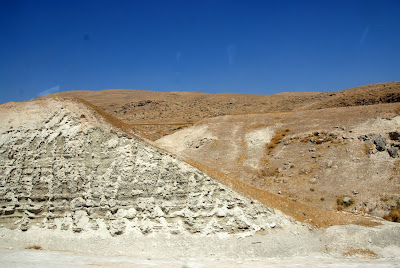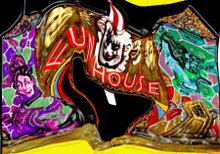On the Road Again and Qumran
So after leaving the Kibbutz, we traveled south and headed for Qumran where the Dead Sea Scrolls were recovered. We got our stuff into the bus and prepared for travel.
The geography changed drastically as we headed south.
It got drier and hotter. This is a archaeological site and national park we passed several times. It is called Korazim: (Or כורזים; also Karraza, Kh. Karazeh, Chorizim, Kerazeh, Korazin.) Mentioned by both Matthew and Luke in the Christian Gospels, it is a location where Jesus performed "deeds of power" (whatever those were). Nonetheless, the people there were not convinced, so it (along with several others) became a cursed city. The Babylonian Talmud also mentions the city as being an important location for grain.
Chorazim is also the locationof a 3rd centrury CE synagogue. Two lion figures were found there along with other artifacts from a couple of different cultural periods. There are many sites in the park and this is just one of them
As we continued south we encountered vacationers at the camping gorunds and resorts.
There were a lot of fruit and date plantations along the Sea of Galilea. Thge palms were full of dates, but I could never get a good picture as we whizzed past them.
You can see some almost on the left of the picture below.
We also passed Beduoin settlements here and there.
The dunes became more prominent.
Israeli's often have cute images for toilets.
Here is another Beduoin community.
The landscapes were brutal and fascinating.
Love this parking "lot"!
We saw a lot of transport animals as we went south.
And we kept going into more barren dessert.
Finally we arrived at Qumran. Qumran was a Hellenistic settlement about 1 mile Northwest of the Dead sea that was destroyed by the Romans in 68 CE. In 1947 a French priest and archaeologist using the writings of Josephus Flavius excavated the area. Scrolls have been found in caves in the mountains above the site. Wikipedia notes, "Nearly 900 scrolls were discovered. Most were written on parchment and some on papyrus. Cisterns, Jewish ritual baths, and cemeteries have been found, along with a dining or assembly room and debris from an upper story alleged by some to have been a scriptorium as well as pottery kilns and a tower.
Many scholars believe the location was home to a Jewish sect, probably the Essenes. But, according to Lawrence Schiffman, the rules of the community, its heavy stress on priesthood and the Zadokite legacy, and other details indicate a Sadducean-oriented sect either distinct from or one of the various Essene groupings.[2] Others propose non-sectarian interpretations, some of these starting with the notion that it was a Hasmonean fort that was later transformed into a villa for a wealthy family, or a production center, perhaps a pottery factory or something similar." https://en.wikipedia.org/wiki/Qumran
The site is hot and dry and not as interesting (to me anyway) as other places we have been, but the scrolls are by far the most interesting thing about the place.
Unfortunately, it seems probable that the priest that lead the excavation was unduly influenced by the writings of Josephus Flavius and thus it was unclear what data he might have overlooked in his quest to find a monastic sect guarding a rare religious trove. The large quantities of material object may speak against the idea of an ascetic group of male monastics as well as the bodies of some women, but there is a great deal of publication on this site and it is hard to know who's theories are most valid.
I decided to climb up to the first accessible cave.
This is a series of photos as I got higher up the mountain.
This is the cave I got to. ;-) Being moderately afraid of heights, that was enough for me.
The site below has a number of deep pools and cisterns causing Father De Vaux to believe that there was a lot of ritual bathing on a daily basis.
This is a picture that shows cave 4 where several hundred scrolls were found. The cave was actually a manmade enclosure. An expert in our group suggested the scrolls may have been retired texts which because they are holy, cannot be destroyed so they were stored in caves.
After Qumran we were ready for a shower or swim at our super cool resort in Ein Geddi.







































No comments:
Post a Comment